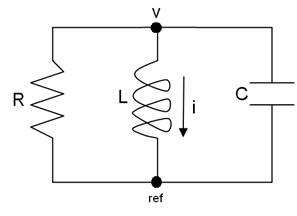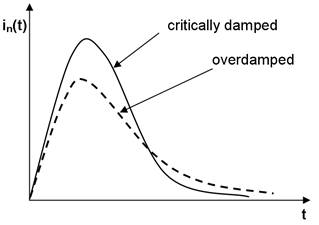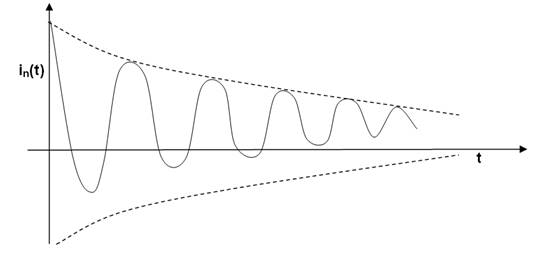First: A Recap of First Order Circuits
We know how to find the response, x(t), of any first order circuit.
(And by response, we mean a current or a voltage,
usually an inductor current or a capacitor voltage.)

The response will always look like this:
![]()
where
For the special case of a constant forcing function the response looks like this:
![]()
These results came from our previous work.
In case you forgot, this is how we did it:
![]()
where x, t and y(t) are defined above
Now: Second Order Circuits
i.e. circuits with two (irreducible) energy storage elements
These circuits are described by a second order differential equation.
Hence they are called second order circuits.
The most general form of a 2nd order differential equation is:
![]()
The solution to these will be a bit more complex than for first order circuits.
The steps to solving higher order circuits:
Step 1: Finding the differential equation of a circuit
Use the State Variable Method. (Steps are on the next page.)
This method can be extended to circuits with any number of energy storage elements.
Step 2a: Finding the natural response
The natural response, xn(t), is found by setting the forcing function of the differential equation to zero. The natural response will have the same number of arbitrary constants as the order of the differential equation. (Don’t try to solve for these constants yet.) Usually this response will die out as t gets large. So it is also called the transient response.
Step 2b: Finding the forced response
The forced response, xf(t), must satisfy the differential equation with no arbitrary constants. Find it by guessing a solution that is the most general form as the forcing function and substitute it into the differential equation to determine the constants.
Step 2c: Finding the complete response
Put them together: x = xn + xf
Step 3: Finding the arbitrary constants in the solution
Once you have the complete response, use the initial conditions of the circuit to solve for the arbitrary constants.
Beware: Don’t try to solve for these constants until you have both the natural response and the forced response. You need to use the complete response to plug the initial conditions into, not just the natural response.
The above gives the big picture. Now we will delve into the details.
State Variable Method
for finding differential equation of a nth order circuit
First find the nth order differential equation for the circuit:

This is the second-order differential equation for the circuit!
Now find the natural response:
Now find the forced response:
Now find the complete response:
Now find the arbitrary constants:
Finding the natural response, xn(t), of a second order circuit
For the differntial equation:
![]()
We guess a solution of: xn(t) = Aest
Substitute this guess into the differential equation and simplify: a2s2 + a1s + ao = 0
This is called the characteristic equation of the differential equation.
It is also known as the characteristic equation of the circuit.
Solve for the roots, s1 and s2, of the characteristic equation: ![equation: s1,2 = -a1/2a2 +/- sqrt [(a1/2a2)^2 - a0/a2]](Second-Order-Circuits_clip_image016.gif)
The natural response is thus: xn(t)= A1es1t + A2es2t
We are happy with this answer since we need a solution that has as many arbitrary constants as the degree of the equation. However, there are 3 possible cases for the values of the roots, s1 and s2, and these different values will alter the character of the natural response.
The roots of the characteristic equation determine the character of the natural response.
Case 1: The Overdamped Response
The roots are negative, real and distinct: (a1/2a2)2 > (a0/ a2)
There is no problem here.
The solution is simply what we determined above.
![Equation: xn(t)= A1 exp(s1t) + A2 exp(s2t) where s1,2 = -a1/2a2 +/- sqrt [(a1/2a2)^2 - a0/a2]](Second-Order-Circuits_clip_image018.jpg)
Case 2: The Critically Damped Response
The roots are negative, real and indistinct: (a1/2a2)2 = (a0/ a2)
Here we have a problem. xn(t) = (A1 + A2)est = A3est is a solution with only one arbitrary constant.
This is not OK! (Because this is a second order circuit we know we need 2!)
So we need to go back and guess a different solution to the differential equation.
Let’s try xn (t) = (A1 + A2t) est.
After substituting this into the differential equation, with some work, we find that it works.
So for this case the solution is:

Case 3: The Underdamped Response
The roots are distinct and complex: (a1/2a2)2 < (a0/ a2)
There is no problem here. Complex numbers don’t scare us.
The solution is simply what we determined above.
However, we can manipulate this solution with Euler’s theorem: cos q + j sinq = ejq
and after a bit of algebraic work this solution will be in a preferred form:
![Equation: xn(t) = exp(st) (A1 cos wdt + A2sinwdt ) where s = -a1/2a2 and wd = sqrt [ a0/a2 - (a1/2a2)^2 ]](Second-Order-Circuits_clip_image022.jpg)
The Source Free Parallel RLC Circuit

L & C may have initial energy storage:
iL(0) = Io
vC(0) = Vo
The second order differential equation for this circuit is:

The natural solution is will depend on the roots of the characteristic equation.

These roots, s1 and s2, will depend on the values of R, L and C.
There are 3 possibilies for the values of the roots which correspond to the 3 cases for the natural response of the circuit:
To make the solution of this equation more manageable, we define the following:
Let:
a = 1 /(2RC) = neper frequency or exponential damping coefficient
wo = 1 /(LC)1/2 = resonant (radian) frequency
wd = (wo2 – a2)1/2 = damped resonant frequency
j = a/wo = damping ratio (dimensionless)
(Note that all except the damping ratio have units of sec-1.)
Hence the roots are:
![]()

The curves shown here start at 0 which means that the initial voltage across the capacitor was 0.
Overdamped Response: a > wo
s1, s2 are negative, real and distinct: LC > 4R2C2
![]()
Critically Damped Response: a = wo
s1, s2 are negative, real and same: LC = 4R2C2
![]()
Underdamped Response: a < wo
s1, s2 are distinct and complex: LC < 4R2C2)
![]()
Notes:
The Source Free Series RLC Circuit

L & C may have initial energy storage:
iL(0) = Io
vC(0) = Vo
The second order differential equation for this circuit is:
![]()
Depending on the values of R, L and C, the natural response will be either
Overdamped, Critically Damped or Underdamped.
As with the parallel circuit, to make the solution of this more manageable, we define the following:
Let:
a = R/(2L) = neper frequency or exponential damping coefficient
wo = 1/ (LC)1/2 = resonant (radian) frequency
wd = (wo2 – a2)1/2 = natural resonant frequency
j = a/wo = damping ratio (dimensionless)
Note: the first is the only one that is different from the parallel RLC circuit.
Hence:
s1, s2 = – a + (a2 – wo2)1/2 = complex frequencies or natural frequencies
Overdamped Response: a > wo
s1, s2 are negative, real and distinct: LC > 4L2/R2
![]()
Critically Damped Response: a = wo
s1, s2 are negative, real and equal: LC = 4L2/R2
![]()

Underdamped Response: a < wo
s1, s2 are distinct and complex: LC < 4R2C2
![]()

Note:
Although this is the dual of the underdamped case for the parallel RLC circuit, it looks different because this particular solution has less damping. Hence the oscillatory nature of the response is more evident. Also, the initial current was not zero here.
The forced response must satisfy the differential equation with no arbitrary constants.

To find it, just guess a form for the forced response that is the most general form of the forcing function:
Forcing |
Assumed |
K |
A |
Kt |
At + B |
Kt2 |
At2 + Bt + C |
K sin wt |
A sin wt + B cos wt |
Ke-at |
Ae-at |
The constants of the assumed solutions (A, B and C) are determined by substituting the assumed solution back into the differential equation.
Note:
If one of the natural response terms has the same form as the forcing function then we need another form of the forced response.
In general we can use xf = tP xn1 where the integer P is selected so that xf is not duplicated in natural response. (Use the lowest value).
In these cases the forced solution will not have exactly the same form as the forcing function.
Source: https://fog.ccsf.edu/~wkaufmyn/ENGN20/Course%20Handouts/Chap%209%20Second_Order_Circuits.doc
Web site to visit: https://fog.ccsf.edu
Author of the text: indicated on the source document of the above text
If you are the author of the text above and you not agree to share your knowledge for teaching, research, scholarship (for fair use as indicated in the United States copyrigh low) please send us an e-mail and we will remove your text quickly. Fair use is a limitation and exception to the exclusive right granted by copyright law to the author of a creative work. In United States copyright law, fair use is a doctrine that permits limited use of copyrighted material without acquiring permission from the rights holders. Examples of fair use include commentary, search engines, criticism, news reporting, research, teaching, library archiving and scholarship. It provides for the legal, unlicensed citation or incorporation of copyrighted material in another author's work under a four-factor balancing test. (source: http://en.wikipedia.org/wiki/Fair_use)
The information of medicine and health contained in the site are of a general nature and purpose which is purely informative and for this reason may not replace in any case, the council of a doctor or a qualified entity legally to the profession.
The texts are the property of their respective authors and we thank them for giving us the opportunity to share for free to students, teachers and users of the Web their texts will used only for illustrative educational and scientific purposes only.
All the information in our site are given for nonprofit educational purposes